Yoga practices enhance emotional resilience and wellbeing by promoting mindfulness, reducing stress, and fostering self-awareness. Engaging in various styles, such as Hatha or Vinyasa, addresses different emotional needs. Specific poses and breathwork techniques further support relaxation and emotional stability. Community yoga sessions create connections, improving overall emotional health and reducing feelings of isolation.
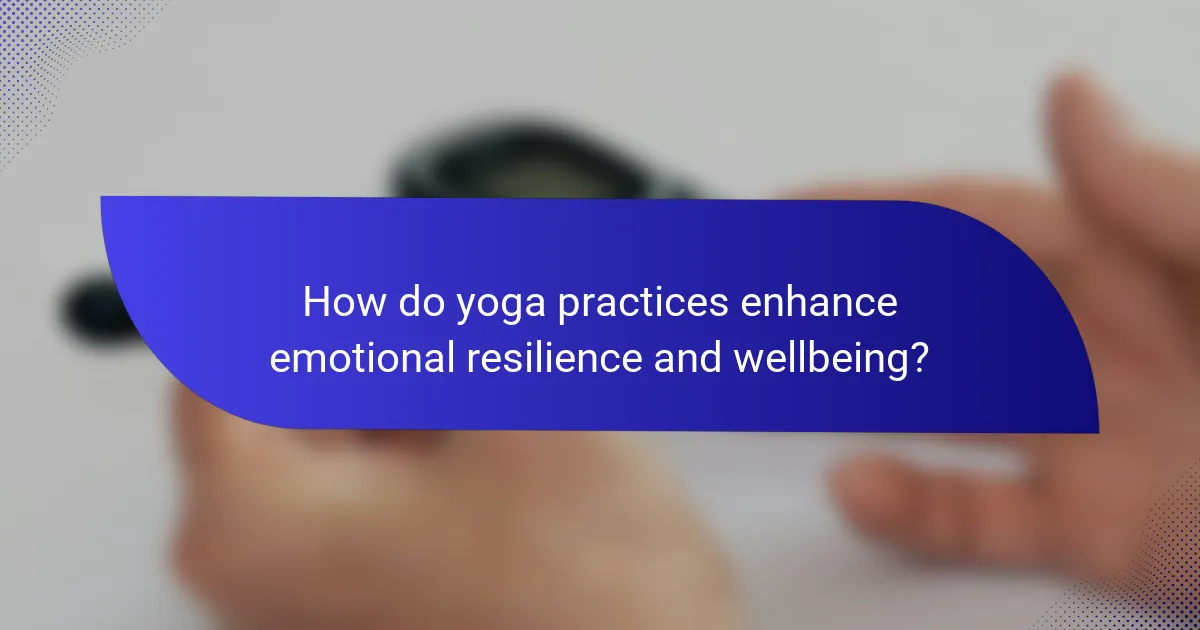
How do yoga practices enhance emotional resilience and wellbeing?
Yoga practices significantly enhance emotional resilience and wellbeing by promoting mindfulness, reducing stress, and fostering self-awareness. Mindfulness techniques in yoga help individuals stay present, which can alleviate anxiety and improve emotional regulation. Regular practice reduces levels of cortisol, the stress hormone, leading to a calmer state of mind.
Additionally, yoga encourages self-reflection and self-acceptance, key components for building emotional strength. Engaging in yoga can also create a sense of community and support, further enhancing emotional wellbeing. Research indicates that individuals who practice yoga regularly report higher levels of life satisfaction and lower levels of depression.
Incorporating various yoga styles, such as Hatha or Vinyasa, can cater to different emotional needs, offering unique benefits for resilience. For instance, restorative yoga focuses on relaxation, while more vigorous styles can boost energy and confidence. Ultimately, the holistic approach of yoga nurtures both the mind and body, contributing to overall emotional health.
What are the key emotional benefits of yoga?
Yoga enhances emotional resilience and wellbeing by promoting mindfulness, reducing stress, and fostering a sense of community. It encourages self-awareness, allowing individuals to process emotions effectively. Regular practice can lead to increased emotional stability, improved mood, and greater overall happiness. Additionally, yoga’s focus on breath control and physical postures can alleviate anxiety and enhance relaxation, making it a powerful tool for emotional health.
How does yoga promote stress reduction?
Yoga promotes stress reduction by enhancing emotional resilience through mindfulness, breath control, and physical postures. These practices activate the relaxation response, lowering cortisol levels and fostering a sense of calm. Research indicates that regular yoga can significantly improve mood and reduce anxiety. Participants often report increased self-awareness and emotional regulation, contributing to overall wellbeing.
Which yoga styles are most effective for emotional health?
Hatha, Vinyasa, and Kundalini yoga styles are most effective for enhancing emotional health. These practices promote mindfulness, reduce stress, and foster emotional resilience.
Hatha yoga focuses on breath control and physical postures, allowing for deep relaxation and emotional release. Vinyasa yoga emphasizes fluid movement and synchronization with breath, improving mood and reducing anxiety. Kundalini yoga incorporates dynamic movements, breathing techniques, and meditation, enhancing self-awareness and emotional stability.
Research indicates that regular practice of these styles can lead to significant improvements in emotional wellbeing, including reduced symptoms of depression and anxiety. Engaging in these yoga styles fosters a deeper connection to one’s emotions and enhances overall mental health.
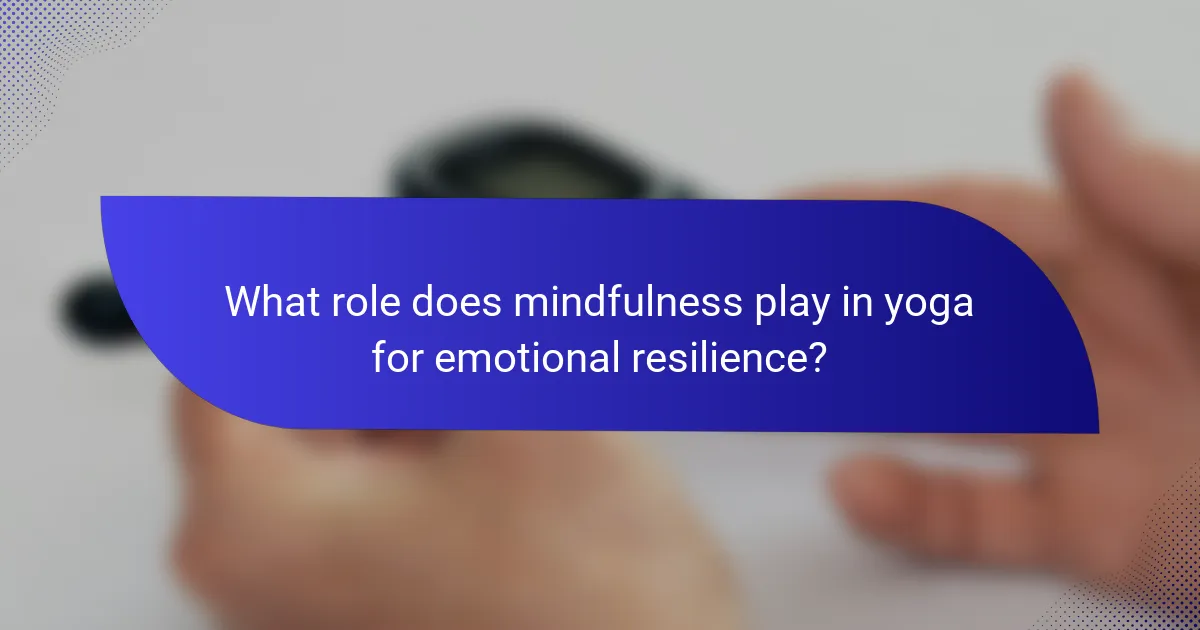
What role does mindfulness play in yoga for emotional resilience?
Mindfulness plays a crucial role in yoga by enhancing emotional resilience. It fosters present-moment awareness, allowing practitioners to process emotions effectively. Regular mindfulness practice during yoga sessions can lead to reduced anxiety and improved mood regulation. Studies show that individuals who integrate mindfulness into their yoga routines experience greater emotional stability and resilience over time. This combination encourages a deeper connection with oneself, promoting overall mental wellbeing.
How can mindfulness techniques be integrated into yoga practice?
Mindfulness techniques can enhance yoga practice by fostering present-moment awareness. Integrating breath awareness, body scans, and mindful movement can deepen emotional resilience and overall wellbeing. These practices help cultivate a non-judgmental attitude, promoting self-acceptance and reducing stress. Regular incorporation of mindfulness can lead to improved emotional regulation and a greater sense of connection to oneself.
What are the psychological benefits of combining mindfulness and yoga?
Combining mindfulness and yoga offers significant psychological benefits, enhancing emotional resilience and overall wellbeing. These practices foster self-awareness, reduce stress, and improve mood.
Mindfulness in yoga encourages present-moment awareness, which helps individuals manage anxiety and negative thoughts. Studies show that regular practice can decrease symptoms of depression and increase feelings of calm.
Additionally, the integration of mindfulness with yoga promotes emotional regulation by enhancing the ability to respond to stressors with equanimity. This combination strengthens coping mechanisms and improves interpersonal relationships.
Practicing mindfulness during yoga also cultivates a greater sense of self-acceptance and compassion, which are crucial for emotional resilience. Participants often report increased life satisfaction and improved mental clarity as a result.
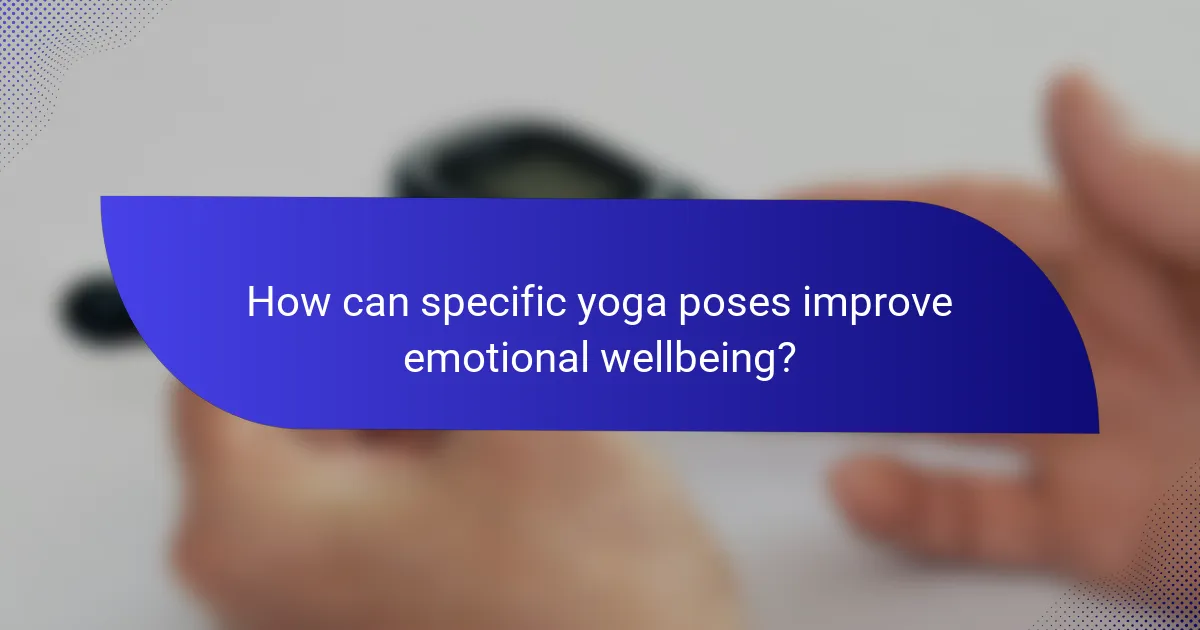
How can specific yoga poses improve emotional wellbeing?
Specific yoga poses can significantly enhance emotional wellbeing by promoting relaxation, reducing anxiety, and fostering mindfulness. Poses such as Child’s Pose and Corpse Pose encourage deep breathing, which calms the nervous system. Additionally, standing poses like Warrior I and II build confidence and resilience through physical strength and grounding. Incorporating these practices into a routine can lead to improved mood and emotional stability. Research indicates that regular yoga practice can reduce symptoms of depression and anxiety, contributing to overall emotional health.
Which poses are best for anxiety relief?
The best yoga poses for anxiety relief include Child’s Pose, Legs-Up-the-Wall Pose, and Cat-Cow Pose. These poses promote relaxation, reduce tension, and enhance emotional resilience.
Child’s Pose stretches the back and calms the mind. Legs-Up-the-Wall Pose encourages blood flow and induces a sense of peace. Cat-Cow Pose helps release stress and improve breath awareness.
Incorporating these poses into a daily routine can significantly enhance emotional wellbeing and resilience against anxiety.
How do restorative poses support emotional balance?
Restorative poses in yoga significantly enhance emotional balance by promoting relaxation and reducing stress. These poses, such as supported child’s pose and legs-up-the-wall, activate the parasympathetic nervous system, fostering a sense of calm. As a result, practitioners often experience decreased anxiety and improved mood stability. Research indicates that regular practice of restorative yoga can lead to long-term emotional resilience, making it a valuable tool for mental well-being.
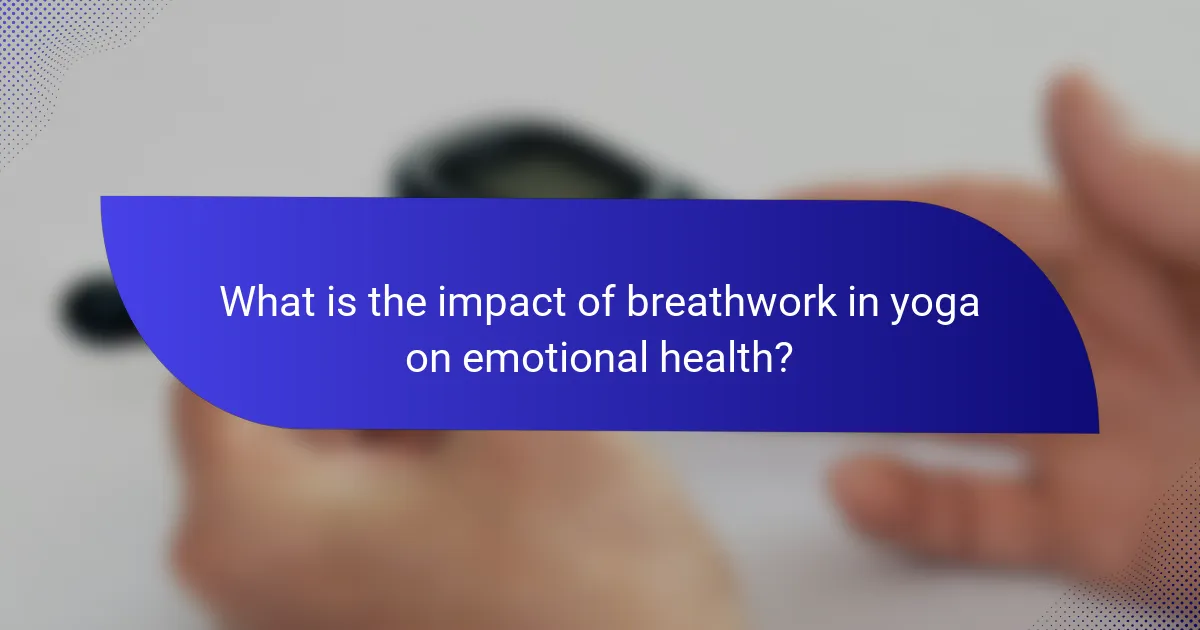
What is the impact of breathwork in yoga on emotional health?
Breathwork in yoga significantly enhances emotional health by promoting relaxation and reducing stress. It fosters emotional resilience through regulated breathing techniques, which can lead to improved mood and mental clarity. Regular practice can lower anxiety levels and increase feelings of well-being. Studies indicate that breathwork activates the parasympathetic nervous system, contributing to emotional stability. This holistic approach addresses both the physiological and psychological aspects of emotional health, making it a powerful tool for overall well-being.
How does breath control influence emotional state?
Breath control significantly influences emotional state by regulating stress and promoting relaxation. Through techniques such as pranayama, individuals can enhance emotional resilience and wellbeing. Controlled breathing lowers cortisol levels, reduces anxiety, and fosters mindfulness. Research indicates that consistent practice can lead to improved emotional regulation and a greater sense of calm. As a result, breath control serves as a powerful tool in yoga practices aimed at enhancing overall emotional health.
Which breathing techniques are most beneficial for resilience?
Breathing techniques like diaphragmatic breathing, box breathing, and alternate nostril breathing enhance emotional resilience. These practices promote relaxation, reduce stress, and improve focus. Diaphragmatic breathing encourages deep, slow breaths, activating the parasympathetic nervous system. Box breathing provides a structured rhythm, aiding in stress management. Alternate nostril breathing balances energy and calms the mind, fostering emotional stability. Regular practice of these techniques can significantly improve overall wellbeing.
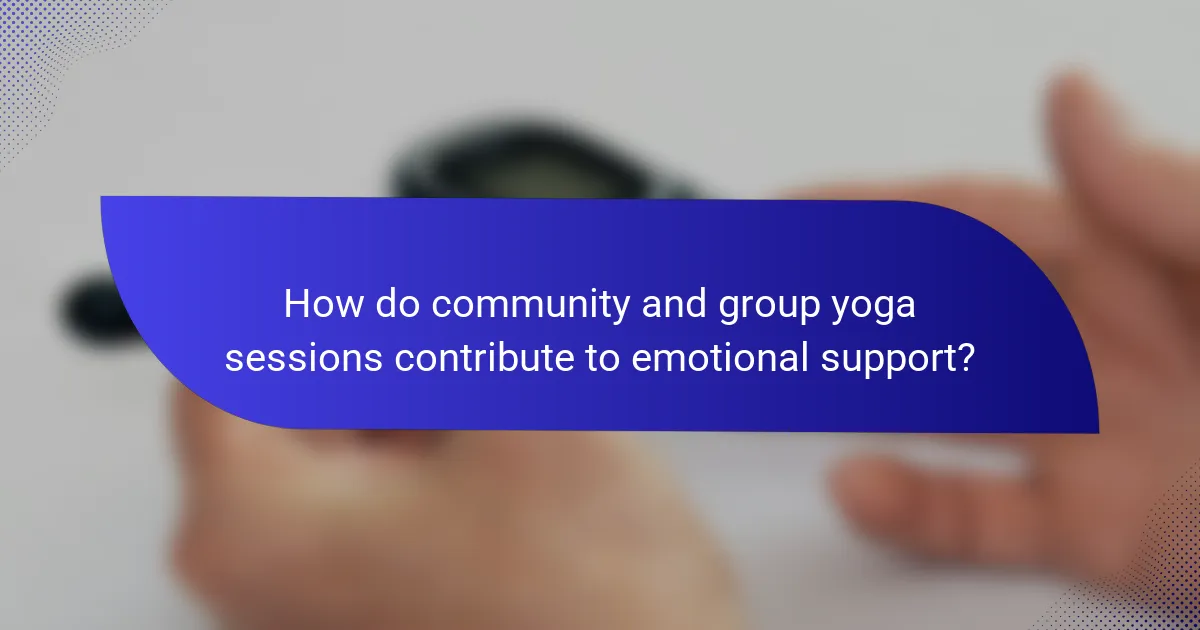
How do community and group yoga sessions contribute to emotional support?
Community and group yoga sessions significantly enhance emotional support by fostering connection and shared experiences. Participants often report feeling less isolated, which improves overall emotional resilience.
These sessions create a safe environment where individuals can express their feelings. The shared practice promotes empathy and understanding among members, strengthening social bonds.
Moreover, group dynamics can motivate individuals to engage more deeply in their practice. This collective energy often leads to heightened emotional awareness and personal growth.
Research indicates that social support is crucial for mental health. Engaging in community yoga can lead to reduced stress and anxiety levels, contributing to improved emotional wellbeing.
What are the social benefits of practicing yoga in groups?
Practicing yoga in groups enhances social connections, fosters community support, and improves emotional resilience. Group settings create a shared experience that encourages mutual encouragement and accountability.
Social interaction during yoga promotes feelings of belonging and reduces loneliness. Research indicates that group activities can elevate mood and decrease anxiety, contributing to overall well-being.
Additionally, practicing in a group can lead to increased motivation. Participants often push each other to maintain consistency and deepen their practice. This collective energy can transform individual challenges into shared journeys of growth.
In summary, group yoga practices offer significant social benefits that enhance emotional resilience and overall well-being.
How can group dynamics enhance emotional resilience?
Group dynamics can significantly enhance emotional resilience by fostering a supportive environment. Engaging in yoga practices within a group setting encourages shared experiences and emotional bonding. This collective participation helps individuals feel less isolated, promoting a sense of belonging.
Research shows that group yoga sessions can lead to improved emotional regulation and stress reduction. Participants often report increased motivation and accountability, which are essential for maintaining a consistent practice. Additionally, the diversity of perspectives within the group can provide unique insights, enriching personal growth and resilience.
Moreover, the unique attribute of group dynamics in yoga enhances communication skills and empathy, further strengthening emotional resilience. This collaborative approach not only benefits individual participants but also cultivates a positive community atmosphere that supports overall wellbeing.
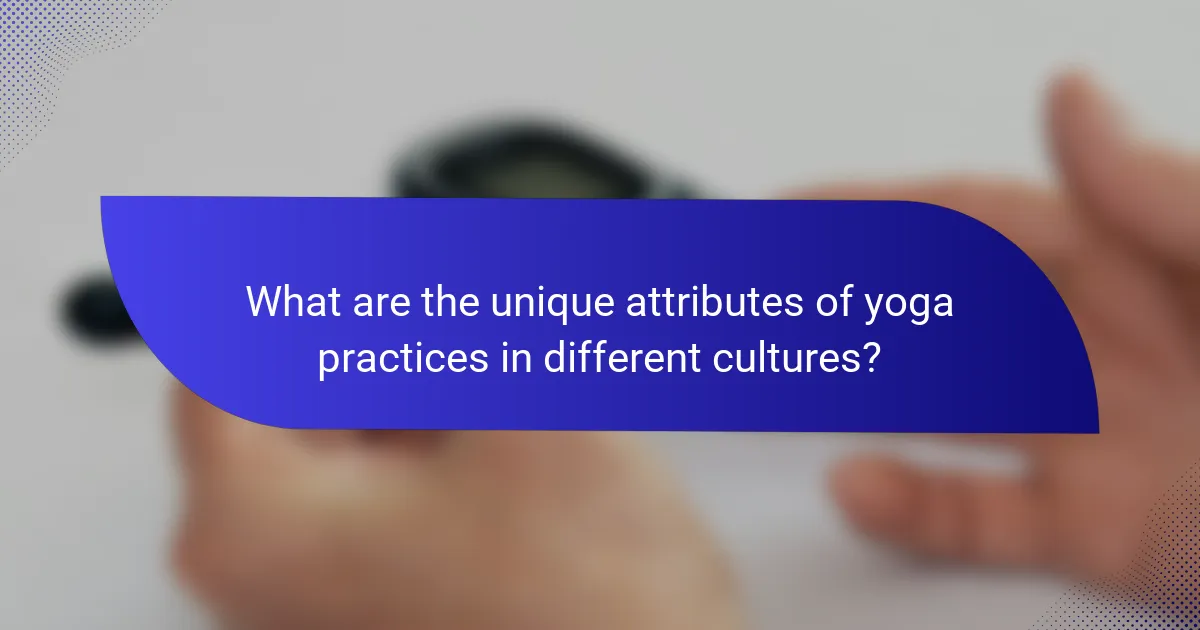
What are the unique attributes of yoga practices in different cultures?
Different cultures exhibit unique attributes in their yoga practices, enhancing emotional resilience and wellbeing. For example, Indian yoga emphasizes mindfulness and spiritual growth, while Western practices often focus on physical fitness and stress relief.
The incorporation of local traditions influences these practices. In Japan, restorative yoga integrates principles of Zen, promoting tranquility. African yoga may incorporate community rituals, fostering social connections.
Cultural backgrounds also shape the types of meditation used. Tibetan yoga often includes chanting, enhancing emotional release. In contrast, Scandinavian practices may prioritize nature immersion, linking the outdoors to emotional health.
These cultural variations highlight the adaptability of yoga, allowing individuals to connect with their emotional needs through diverse practices.
How does the approach to yoga differ across regions?
The approach to yoga varies significantly across regions, influenced by cultural, historical, and environmental factors. In India, yoga emphasizes spiritual growth and meditation, often integrating traditional philosophies. In contrast, Western practices frequently focus on physical fitness and stress relief, prioritizing asanas and breath control.
Asian countries like Japan incorporate mindfulness and Zen principles, blending yoga with local meditation practices. In Africa, yoga is increasingly adopted for wellness and community building, often reflecting indigenous healing traditions.
These regional differences highlight unique attributes, such as the focus on spirituality in India versus the fitness orientation in the West. Understanding these variations enriches the practice of yoga and enhances emotional resilience and well-being.
What cultural practices enhance emotional resilience through yoga?
Cultural practices such as mindfulness, breathwork, and community engagement enhance emotional resilience through yoga. These practices foster a deeper connection to self and others, promoting overall well-being. Mindfulness encourages present-moment awareness, reducing stress. Breathwork regulates emotions by calming the nervous system. Community engagement builds social support, essential for resilience. Together, these practices create a holistic approach to emotional health.
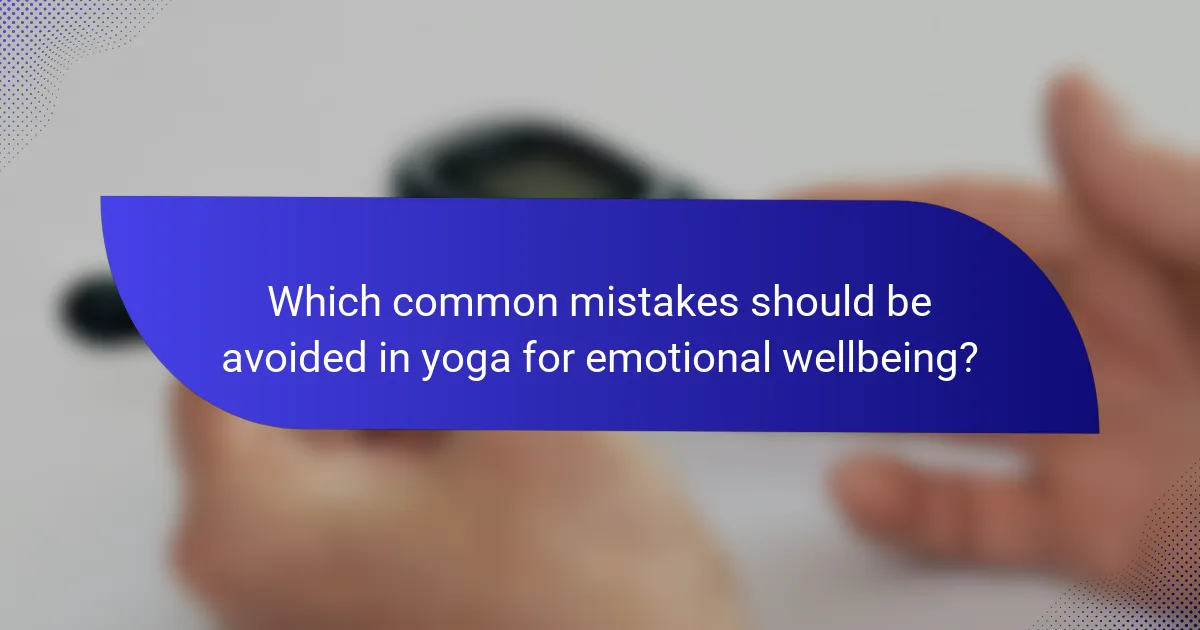
Which common mistakes should be avoided in yoga for emotional wellbeing?
To enhance emotional wellbeing through yoga, avoid common mistakes such as neglecting proper alignment, skipping breathwork, and setting unrealistic expectations. Prioritizing mindfulness and self-compassion is crucial for effective practice.
1. Ignoring alignment can lead to injury and hinder benefits.
2. Overlooking breath control limits emotional release and relaxation.
3. Comparing your practice to others can diminish self-esteem.
4. Practicing without intention may lead to disconnection from emotions.
5. Rushing through poses can prevent deeper emotional exploration.
6. Failing to adapt practices to personal needs can reduce effectiveness.
What are the pitfalls of practicing yoga without guidance?
Practicing yoga without guidance can lead to several pitfalls, including improper alignment, increased risk of injury, and ineffective practice. Without an instructor, individuals may not learn the correct techniques, which can hinder emotional resilience and overall wellbeing.
Inadequate knowledge of poses can result in physical strain, particularly for beginners who may not recognize their limits. Additionally, without guidance, practitioners might develop bad habits that are difficult to correct later.
Moreover, emotional benefits of yoga can be diminished without proper instruction. An experienced teacher can provide tailored feedback, ensuring that the practice is aligned with individual emotional needs.
Lastly, the absence of a supportive community can reduce motivation and accountability, making it harder to maintain a consistent practice that fosters emotional resilience.
How can misalignment in practice affect emotional outcomes?
Misalignment in yoga practice can lead to negative emotional outcomes. When practitioners do not align their physical movements with their breath, they may experience increased stress and anxiety. This disconnect can hinder emotional resilience and overall wellbeing.
Inconsistent practice can also result in frustration, reducing motivation and engagement. As a result, individuals may miss the emotional benefits that consistent and mindful yoga practice can provide. Emotional regulation, a key benefit of yoga, diminishes when alignment is neglected.
Moreover, misalignment can create physical discomfort, which may distract from the meditative aspects of practice. This distraction can prevent individuals from achieving a state of calmness and clarity, essential for emotional health.
Ultimately, maintaining alignment in yoga is crucial for fostering emotional resilience and enhancing wellbeing. Practitioners should focus on integrating breath and movement to fully access the emotional benefits of their practice.
What expert tips can enhance the effectiveness of yoga for emotional resilience?
Incorporating expert tips can significantly enhance the effectiveness of yoga for emotional resilience. Focus on consistent practice, integrating mindfulness techniques, and exploring various styles of yoga to find what resonates with you.
1. Establish a regular schedule to create a routine that fosters emotional stability.
2. Incorporate breathwork to enhance relaxation and reduce anxiety.
3. Utilize guided meditations to deepen mindfulness and self-awareness.
4. Experiment with different yoga styles, such as Hatha for grounding or Vinyasa for flow, to discover personal preferences.
5. Set intentions for each session to cultivate a positive mindset.
6. Join a community or class for social support and shared experiences.
These practices can help build emotional resilience and improve overall wellbeing.